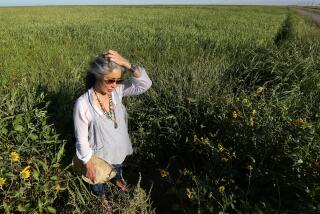Promoter Crusades for More Exports of Brown Rice
- Share via
LITTLE ROCK, Ark. — A television commercial produced by the South Korean government shows ancient warriors who eat brown rice are successful in their invasion of Peking, but once there, their captives feed them white rice and the weakened warriors are driven away.
Promoter Tom Coyne of Little Rock, a proponent of brown rice, said he could use an advertisement like that to spread the word to American farmers and businessmen.
Coyne, since founding Arkansas-based Devark Inc. about five years ago, has been introducing cheaper equipment to Arkansas farmers to use in the processing of brown rice and crusading for larger markets.
Spins a Yarn
The native of Amarillo, Tex., will even spin a West Texas yarn to get attention.
“If you eat brown rice every day--and I’m serious--we guarantee you will live to be 90 years old. Not only will you live to be 90 years old, when you die you will go to heaven,” he said.
Coyne, 57, says the United States’ rice milling industry has emphasized the export of white rice, in which the nutrient-layered brown coating natural to rice is stripped away with synthetic vitamins and minerals added later--a process Coyne said made little sense.
“We have not made any real effort to export brown rice,” Coyne said.
“One of the reasons why the rice-milling industry has lost many of its customers overseas is that we don’t ship what they would prefer to eat, but rather what we would prefer to make a profit selling,” Coyne said.
“They (white rice producers) will tell you brown rice does not keep as well. But all grains become rancid with heat and moisture. If you keep grains dry, there’s very little problem,” Coyne said.
Coyne is hoping the Secretary of Agriculture will realize that point and approve shipments of brown rice, as well as white rice, to famine-stricken areas of East Africa.
“The American rice-milling industry wants to make a product that’s most profitable. So they export white rice, whereas East Africans prefer brown rice,” Coyne said.
Koreans, by the way, will buy only brown rice, he said.
Americans have preferred white rice because it looks more attractive on their plates, Coyne said, although brown rice is more nutritious and is becoming more popular among health-conscious consumers.
“Even the Secretary of Agriculture says he eats brown rice,” Coyne said.
Coyne has been concentrating his efforts on convincing farmers in Arkansas, a major rice-producing state, of the savings of on-farm production.
“Arkansas has some of the best rice in the world,” he said.
Coyne has imported from China a low-cost rice huller to strip the brown rice husk off the kernal.
The huller allows the farmer to earn about twice what he would earn if he shipped his rice to a mill, he said. The farmer also eliminates a wasted transportation cost charged him for the pounds of hulls attached to the rice.
“It doesn’t make any sense that people have to pay $1 a pound for brown rice in natural food stores in Chicago and New York when rice farmers here can produce brown rice at less than 13 cents a pound,” he said.
Coyne, 57, has worked in Indonesia, Bangladesh and Sri Lanka in brown rice production and marketing.
Since his arrival in Arkansas, he has courted rice farmers in eastern Arkansas, arranging contracts to ship the Arkansas-grown variety to poverty centers in the United States as well as points abroad such as Brazil and Lebanon.
The Winthrop Rockefeller Foundation, based in Little Rock, also helped the Interfaith Hunger Task Force to set up the Rice Depot, which distributes brown rice at no cost to religious organizations and county health clinics, where it’s given to any pregnant women,” Coyne said.
More to Read
Inside the business of entertainment
The Wide Shot brings you news, analysis and insights on everything from streaming wars to production — and what it all means for the future.
You may occasionally receive promotional content from the Los Angeles Times.










